Formnext 2018: International forum reviews standards for Additive Manufacturing
Organised by the U.S. Commercial Service in Dusseldorf, Germany, the Additive Manufacturing/3D Printing Standards Forum took place on November 14, 2018, in Frankfurt, Germany, at the Formnext trade fair. As Dr Georg Schlieper reports, the event brought together leading experts from industry, research institutions, standards developing organisations, professional societies and government to address key themes focused on standards development in AM technologies. This included progress on international standards development for AM and how the use of these standards can help the industry achieve its potential. [First published in Metal AM Vol. 4 No. 4, Winter 2018 | 10 minute read | View on Issuu | Download PDF]
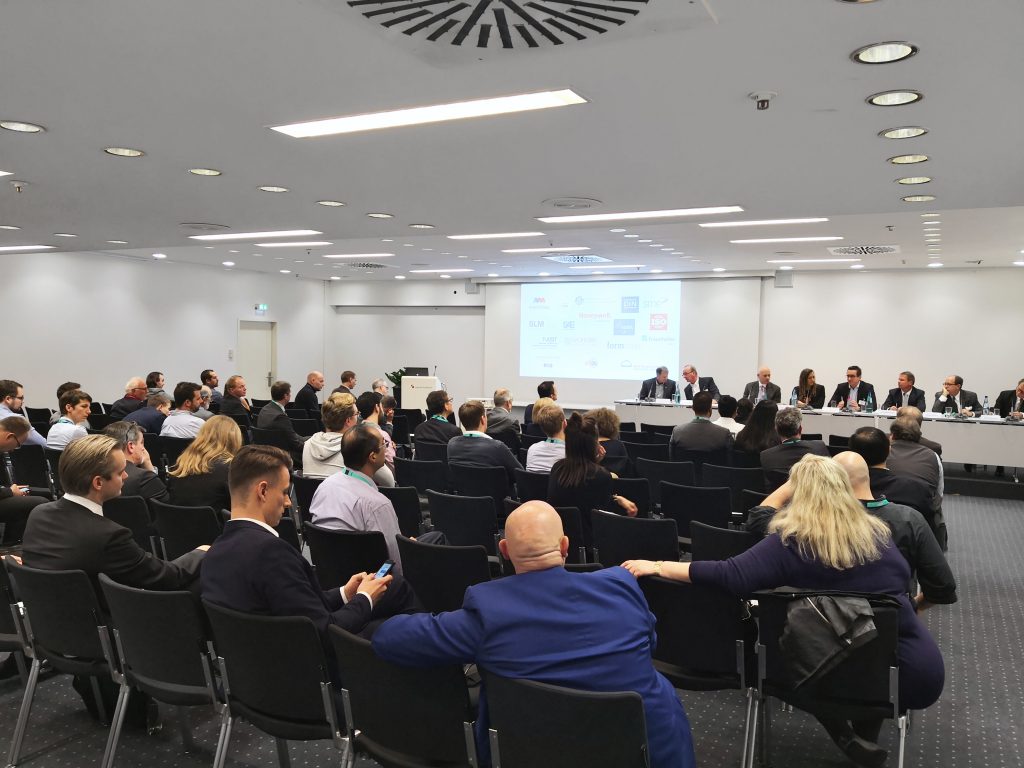
The importance of industrial standards for an emerging industry such as Additive Manufacturing is widely recognised. Standards are needed for a variety of purposes. Among other things, they facilitate and harmonise communication between suppliers and customers, determine and document the requirements for materials and products, define test methods and resulting protocols, and ensure safe procedures that are consistent with ethical principles, gentle on the environment and as safe as possible for the health of the workforce and end users. Besides industry and trade, standards are also referenced by government regulatory agencies and certifying bodies in their regulations and procedures. In a globalised industry, all standards should be harmonised at an international level.
In order to bring the AM industry closer to this goal, a standards workshop was held on November 14, 2018, during Formnext in Frankfurt, Germany, attended by high-level experts from Standards Developing Organisations (SDO), government and industry. The Additive Manufacturing Standards Forum was chaired by Terry Wohlers, President of Wohlers Associates, who opened the half day event by welcoming the audience and introducing the topic. Opening statements were then made by John McCaslin, Minister Counselor for Commercial Affairs and Regional Senior Commercial Officer, US Commercial Service at the US Embassy in Berlin, and Dr Thomas Zielke, Head of Division Technology Transfer at the German Federal Ministry for Economic Affairs and Energy.
NIST describes the importance of AM standards
Kevin Jurrens, Deputy Chief of the Intelligent Systems Division of the U.S. National Institute of Standards and Technology (NIST), gave a U.S. federal government agency perspective on Additive Manufacturing standards as well as a broader summary of AM standards development activities across the multiple SDOs. NIST supports innovation in the American industry by developing test methods, measurement tools, performance measures and scientific data. The role of NIST is to identify consensus needs and priorities for standards through workshops, industry meetings, outreach events, etc. The institute carries out scientific research to develop the technical basis for standards and disseminates research in collaboration with the private sector and academic organisations. NIST is active in standards committees, often in a leadership role, initiating the development of technical standards, preparing strategic plans and supporting coordination, facilitation and communication among standards groups.
Examples of measurement science for Additive Manufacturing, one of the major competencies of NIST, are the development of methods to characterise the powder bed density and recyclability of metal powders, methods to characterise built materials and the generation of sound databases in round robin studies and variability analyses. NIST operates an Additive Manufacturing Metrology Testbed (AMMT) that allows it to monitor and control the powder bed-based AM process in-situ in order to robustly predict part quality. These investigations are used to generate reference data and find correlations between process parameters, process signatures and part quality to enable the intelligent design of control devices.
Reference data are used for computer modelling to improve model inputs and validate model outputs in terms of temperature, microstructure, residual stresses, etc. X-ray Computer Tomography (CT) is used to assess the part quality and to characterise the machine performance. NIST has also developed the architecture of an AM Information System including metrics, information models and validation models. A public AM Material Database (AMMD) has been launched, populated with round robin data. Further activities of NIST are focused on product definition and tolerance representation for AM and fundamental principles of AM design rules.
Standards bodies relevant to AM
ASTM International and ISO
A number of standards bodies are involved in or have work that is relevant to Additive Manufacturing. Two leading SDOs on an international level, ASTM International and the International Organization for Standardization (ISO), have agreed on a formal collaboration between their Technical Committees ASTM F42 and ISO TC 261 focusing on AM Standards. The various sectors of AM Standards such as terminology, test methods, materials and processes, quality specifications, design, environment and health and safety are addressed by several subcommittees (ASTM) and working groups (ISO). The guiding principles and specific procedures for the cooperation of ASTM and ISO are defined in the ‘Joint Plan for Standards Development’. The goal is that the resulting AM standards, issued under the dual-logo of ISO and ASTM, will be used all over the world and there will be no need for future harmonisation. According to Kevin Jurrens, this is the first time that these standards bodies have agreed upon such a close and in-depth cooperation.
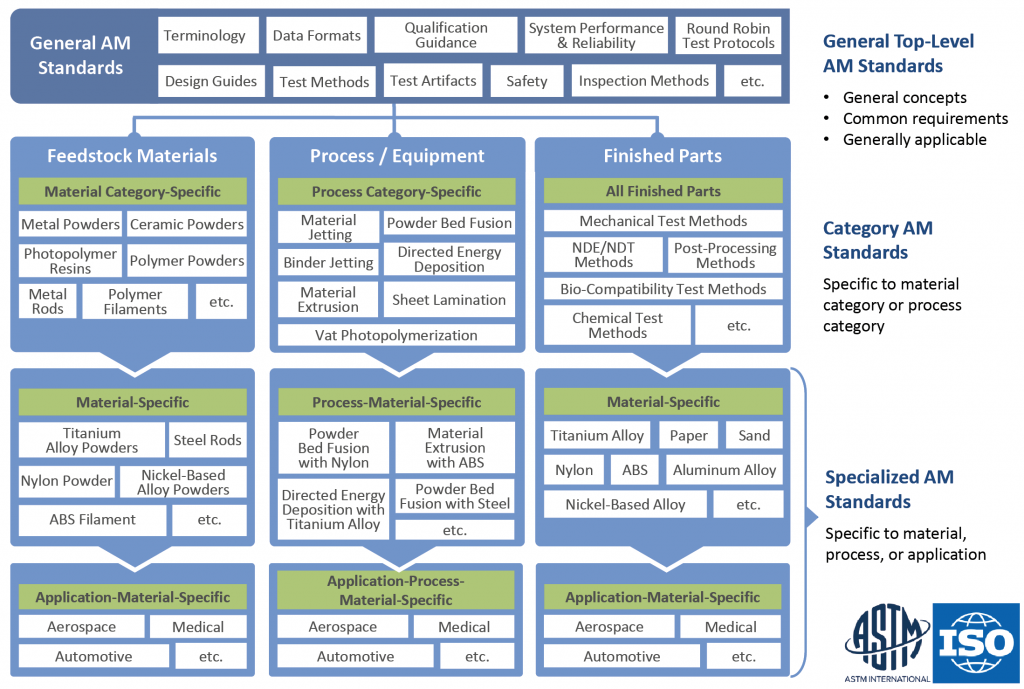
To gain an overview of the large number of standardisation tasks for AM technology, the table shown in Fig. 2 is helpful. The general top-level standards refer to general concepts, common requirements and are generally applicable. Below these are the standards for raw materials, processes and the characterisation of finished products. These are followed by standards for special materials and applications.
The European Committee for Standardisation
The European Committee for Standardisation (CEN), with its Technical Committee CEN/TC 438, has so far adopted ISO standards without any change, so that there is currently no need for harmonisation. These EN ISO/ASTM standards are adopted for use by all EU member countries, thereby strengthening collaboration on standards and facilitating commerce.
SAE International
Other standards bodies focus their activities on special sectors of AM. SAE International, formerly known as the Society of Automotive Engineers, was represented during the forum by John Clatworthy. The organisation has established a committee on Aerospace Material Specifications for Additive Manufacturing (AMS-AM), with subcommittees for metals and polymers. The first four material specifications (AMS7000–AMS7003) were issued in June 2018 (Table 1)and relate to Laser Beam Powder Bed Fusion (LB-PBF) Alloy 625.
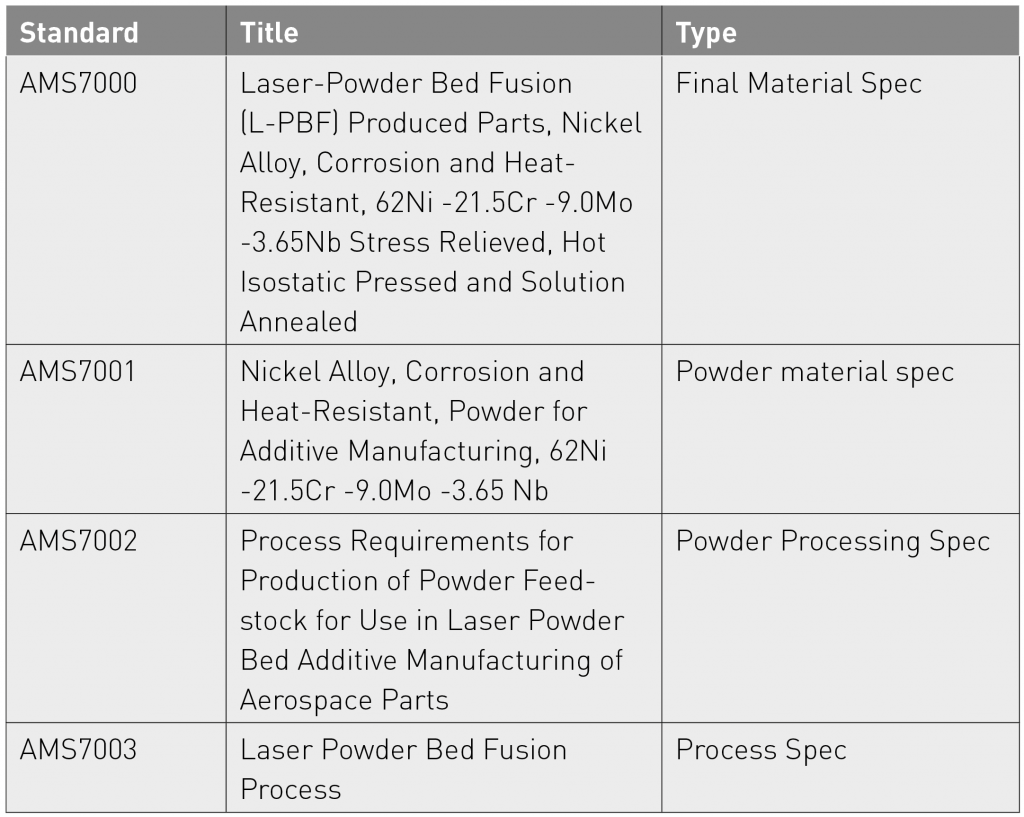
American Society of Mechanical Engineers
The American Society of Mechanical Engineers (ASME) standards committee Y14.46 works on Geometric Dimensioning & Tolerancing (GD&T) requirements unique to AM. The objective is to specify free-form complex surfaces and internal features, lattice and support structures, as-built assemblies, properties depending on the build-direction, multiple and functionally gradient materials, etc. GD&T is the language for communicating the specification of geometric tolerances and design intent from the designer to the manufacturing and quality engineers. The ASME Y14 committee has developed several GD&T standards in the past and can build on long-standing experience in this field. A draft standard, ASME Y14.46 Product Definition for AM, was issued for trial use in 2017.
Another standards committee, ASME B46, is concerned with the classification and designation of surface qualities. The committee has begun a preliminary work item on surface attributes and corresponding characterisation methods that are relevant to components made by AM technology. The topic is still in the early stages of discussion; there is currently no consensus on some details and several open questions need to be answered with further research. For example, it must be investigated whether the usual roughness parameters (Ra, Rt) are suitable for describing the roughness of the sometimes complex surfaces of AM parts.
American Welding Society
The American Welding Society (AWS) develops specifications for the fabrication of metal components using Additive Manufacturing. This work is focused on the requirements for the repeatable production of metal AM components by technologies including Powder Bed Fusion and Directed Energy Deposition (DED) from raw materials in either metal powder or wire form. The current draft covers design requirements for AM components, fabrication requirements, AM machine and procedure qualification, inspection requirements and AM machine operator performance qualification.
The growing AM standards landscape poses a risk of overlapping work and duplication of efforts. When standards committees work independently, there is potential for inconsistencies or even contradictions, resulting in conflicting standards which may create ambiguity and confusion. To avoid this, intensive communication, coordination and liaison among the various organisations involved is indispensable. After all, the resources available for standards development are limited.
Additive Manufacturing Standards Collaborative
In order to pool resources for standardisation, the Additive Manufacturing Standards Collaborative (AMSC) was initiated in March 2016 with the purpose of coordinating and accelerating the development of standards for AM technology, which are consistent with the needs of stakeholders and facilitate the growth of the AM industry. The initiative was supported by the American National Standards Institute (ANSI) through a cooperative agreement with America Makes. Jim McCabe, Senior Director at ANSI, outlined the following overarching goals of the project:
- Facilitate the development of a consistent, harmonised and non-contradictory framework of AM standards and specifications
- Develop a standardisation roadmap describing the current and desired future standards landscape: what’s published, in development, or needed
- Drive coordinated activity among AM standards developing organisations and avoid duplication of efforts
- Inform industry decision-making vis-à-vis resource allocation for standards participation
- Provide subject matter experts to work with SDOs
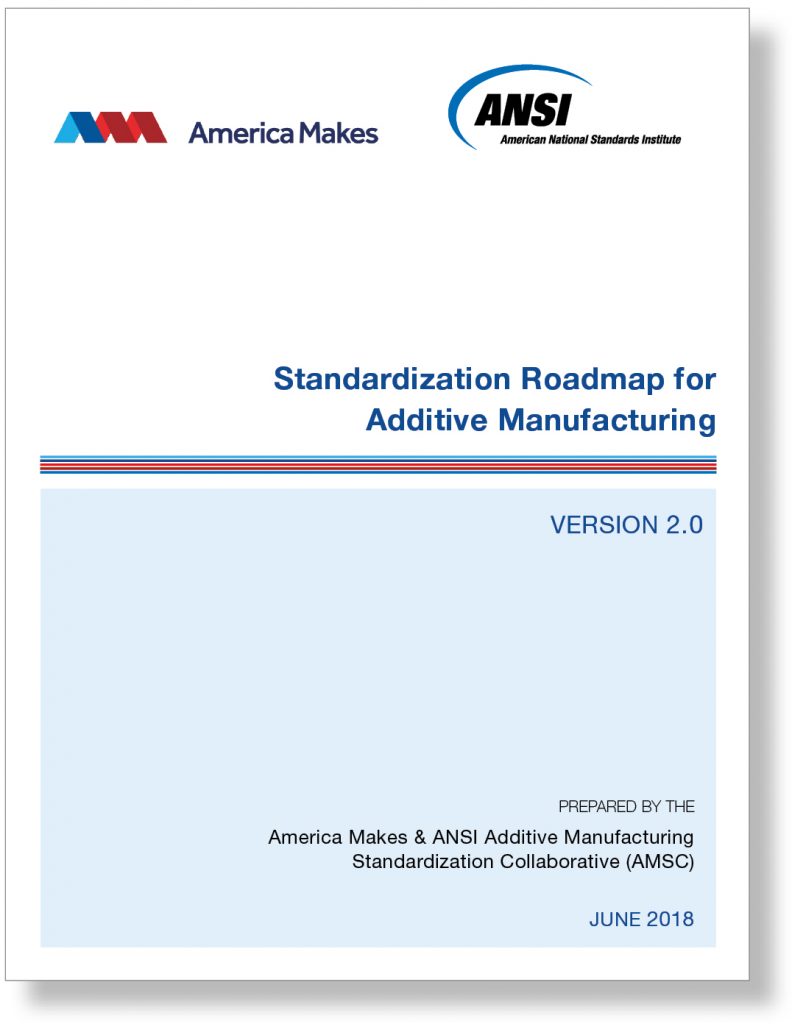
It was noted that AMSC itself is not developing standards. Phase 1, a ‘Standardization Roadmap for Additive Manufacturing’ was released in February 2017. Version 1.0 was replaced by Version 2.0 in June 2018. In this 268 page booklet (Fig. 3), which is available as a free download on the ANSI website, a comprehensive review is given of the standards requirements for AM, existing and needed standards. The roadmap identified ninety-three gaps (needed standards), of which eighteen were classified as high priority, fifty-one as medium priority and twenty-four as low priority. Research is required for sixty-five standards that are to be developed. A list of standards that are directly or peripherally related to the issues described in the roadmap has been published under the title ‘Standards Landscape’, which is also available as a free download.
The roadmap defines the topic areas for standardisation in five basic groups:
- Design
- Process and Materials
- Qualification and Certification
- Non-destructive Evaluation
- Maintenance and Repair
Each basic group is divided into subtopics, which in some cases are further subdivided. We will not go further into detail to avoid overwhelming our readers. Those who are interested in more details can read them in the AMSC Roadmap.
Planned future activities of ASMC are related to further promoting the roadmap and meeting with SDOs to track progress in standardisation. An online table of progress on the gaps in standards is planned and ASMC will also approach other industry sectors beyond aerospace, defence and medical with workshops to encourage them to participate in the standards committees.
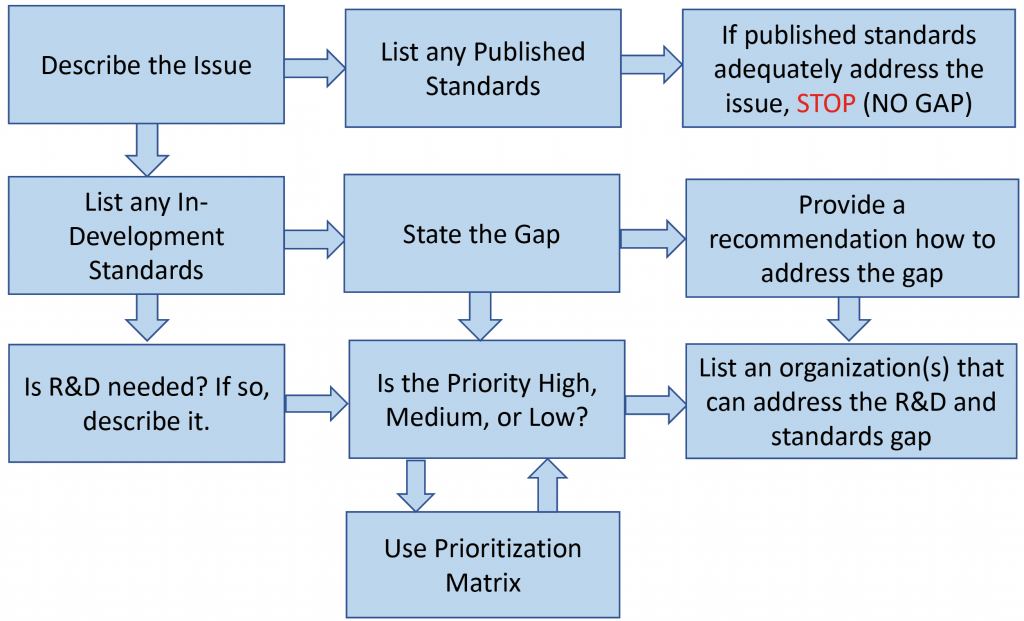
Conclusion
The workshop featured speakers from both sides of the Atlantic. Europe’s contribution to the standards activities was represented by Benjamin Hein, of the German Institute for Standardisation DIN and Secretary of ISO TC 261 ‘Additive Manufacturing’. He stressed the importance of cooperation for consistent international standards and predicted that these will increasingly replace national standards. “A globalised world needs worldwide standards,” he said. “They enhance efficiency and quality, promote trade and make products safe and environmentally friendly.” DIN estimates that the German industry alone saves €17 billion each year thanks to standardisation and fully supports the joint activities of ASTM and ISO.
Hein emphasised that using standards saves R&D and production costs, and that standards provide users and researchers with fundamental expert knowledge that can be used to gain a competitive edge and expand networks. Further, standards facilitate market access and help dismantle barriers to trade, thereby promoting economic growth throughout the world. Conforming to standards shows a commitment to quality, enhancing customer trust, increasing product safety and lowering liability risks.
Author
Dr. Georg Schlieper
Harscheidweg 89
D-45149 Essen
Germany
Tel: +49 201 71 20 98
Email: [email protected]
Resources and useful links
National Institute of Standards and Technology
www.nist.gov
America Makes – National Additive Manufacturing Innovation Institute
www.americamakes.us
ASTM International
www.astm.org
ISO – International Organization for Standardization
www.iso.org
CEN – European Committee for Standardization
www.ce.en
SAE International
www.sae.org
The American Society of Mechanical Engineers
www.asme.org
American Welding Society
www.aws.org







